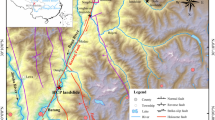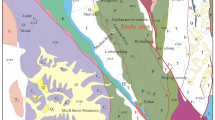Abstract
The geological conditions in the upper reaches of the Jinsha River on the southeastern margin of the Qinghai–Tibet Plateau are extremely complex. Many paleo-landslides and lacustrine sediments were formed in this area under the synergistic effect of tectonic activity and climate. The study of old deposits is helpful for understanding paleoenvironment, paleoclimate, and river geomorphology evolution. This study addressed the Wangdalong landslide damming event as the object and implemented a detailed on-site investigation. The geological characteristics of the landslide body, sliding surface, source area, and lacustrine deposits are determined. The 3D topographic restoration and the SFLOW software were used to simulate landslide dynamics, and the geomorphological evolution sequence of the Wangdalong landslide is proposed. Based on the landslide dating, the mineral analysis of lacustrine sediments, and the numerical simulation, the landslide was determined to be the product of the synergistic effect of climate and structure, and an earthquake or a heavy rainfall was the most probable triggering factor of the landslide. This study established a systematic analysis of the landslide damming event, which has reference significance for similar research.














Similar content being viewed by others
References
Bao YD, Han XD, Chen JP, Zhan JW, Zhang W, Sun XH, Chen MH (2019) Numerical assessment of failure potential of a large mine waste dump in Panzhihua City, China. Eng Geol 253:171–183
Bao YD, Sun XH, Zhou X, Zhang YS, Liu YW (2021) Some numerical approaches for landslide river blocking: introduction, simulation, and discussion. Landslides. https://doi.org/10.1007/s10346-021-01725-2
Bao YD, Zhai SJ, Chen JP, Xu PH, Sun XH, Zhan JW, Zhang W, Zhou X (2020) The evolution of the Samaoding paleolandslide river blocking event at the upstream reaches of the Jinsha River. Tibetan Plateau Geomorphology 351:106970
Chen HX, Zhang LM, Zhang S (2013a) Hybrid simulation of the initiation and runout characteristics of a catastrophic debris flow. J Mt Sci 10(2):219–232
Chen J, Dai FC, Lv TY, Cui ZJ (2013b) Holocene landslide-dammed lake deposits in the Upper Jinsha River, SE Tibetan Plateau and their ages. Quatern Int 298:107–113
Chen J, Zhou W, Cui Z, Li W, Wu S, Ma J (2018) Formation process of a large paleolandslide-dammed lake at Xuelongnang in the upper Jinsha River, SE Tibetan Plateau: constraints from OSL and 14C dating. Landslides 15:2399–2412
Chigira M, Wu XY, Inokuchi T, Wang GH (2010) Landslides induced by the 2008 Wenchuan earthquake, Sichuan. China Geomorphology 118(3–4):225–238
Costa JE, Schuster RL (1988) The formation and failure of natural dams. Bull Geol Soc Am 100:1054–1068
Dai FC, Xu C, Yao X, Xu L, Tu XB, Gong QM (2011) Spatial distribution of landslides triggered by the 2008 Ms 8.0 Wenchuan earthquake, China. J. Asian Earth Sci 40(4):883–895
Dunning SA (2006) Formation and failure of the Tsatichhu landslide dam, Bhutan. Landslides 3:107–113
Du YQ (2015) The study of slope stability of the right lower dam of the Jinsha River Batang hydropower station. Chengdu Univ TecH CNKI:CDMD:2.1017.219228. https://kns.cnki.net (in Chinese)
Evans SG, Delaney KB (2011) Characterization of the 2000 Yigong Zangbo River (Tibet) landslide dam and impoundment by remote sensing. In: Evans S., Hermanns R., Strom A., Scarascia-Mugnozza G. (eds) Natural and Artificial Rockslide Dams. Lecture Notes in Earth Sciences, vol 133. Springer, Berlin, Heidelberg
Gorum T, Fan XM, Van Westen CJ, Huang RQ, Xu Q, Tang C, Wang GH (2011) Distribution pattern of earthquake-induced landslides triggered by the 12 May 2008 Wenchuan earthquake. Geomorphology 133(3–4):152–167
Han XD, Chen JP, Xu PH (2018) Runout analysis of a potential debris flow in the Dongwopu gully based on a well-balanced numerical model over complex topography. Bull Eng Geol Env 77(2):679–689
Han XD, Chen JP, Xu PH, Zhan JW (2017) A well-balanced numerical scheme for debris flow run-out prediction in Xiaojia Gully considering different hydrological designs. Landslides 14(6):2105–2114
Hermanns RL, Niedermann S et al (2004) Rock avalanching into a landslide-dammed lake causing multiple dam failure in Las Conchas valley (NW Argentina) - evidence from surface exposure dating and stratigraphic analyses. Landslides 1(2):113–122
Huang F, Song YX, Ma GW, Pei XJ, Huang RQ (2019) Numerical modeling of the 2008 Wenchuan earthquake-triggered Niumiangou landslide considering effects of pore-water pressure. Bull Eng Geol Env 78:4713–4729
Huang RQ, Fan XM (2013) The Landslide Story Nat Geosci 6(5):325–326
Kong P, Na CG, Fink D et al (2009) Moraine dam related to late Quaternary glaciation in the Yulong Mountains, southwest China, and impacts on the Jinsha River. Quatern Sci Rev 28:3224–3235
Kong P, Zheng Y, Caffee MW (2012) Provenance and time constraints on the formation of the first bend of the Yangtze River. Geochemisry Geophysics Geosystems 13:Q06017
Korup O, Clague JJ (2009) Natural hazards, extreme events, and mountain topography. Quat Sci Rev 28:977–990
Li B, Xing AG, Xu C (2017) Simulation of a long-runout rock avalanche triggered by the Lushan earthquake in the Tangjia Valley, Tianquan, Sichuan, China. Eng Geol 218:107–116
Li JJ, Zhou SZ, Zhao ZJ, Zhang J (2015) The Qingzang movement: the major uplift of the Qinghai-Tibetan Plateau. Sci China Earth Sci 58:2113–2122
Liu HD, Li DD, Wang ZF (2018) Dynamic process of the Wenjiagou rock landslide in Sichuan Province. Chi Arab J Geosci 11:233
Li YC, Chen JP, Zhou FJ et al (2020) Identification of ancient river-blocking events and analysis of the mechanisms for the formation of landslide dams in the Suwalong section of the upper Jinsha River. SE Tibetan Plateau Geomorphology 368:107351
Qin Z, Fu H, Chen X (2019) A study on altered granite meso-damage mechanisms due to water invasion-water loss cycles. Environ Earth Sci 78. https://doi.org/10.1007/s12665-019-8426-6
Reneau SL, Dethier DP (1996) Late Pleistocene landslide-dammed lakes along the Rio Grande, White Rock Canyon. New Mexico Geol Soc Am Bull 108(11):1492–1507
Strom AL (2004) Rock avalanches of the Ardon River valley at the southern foot of the Rocky Range, Northern Caucasus, North Osetia. Landslides 1:237–241
Sun XH, Han XD, Chen JP, Bao YD, Peng W (2021) Numerical simulation of the Qulong paleolandslide dam event in the late Pleistocene using the finite volume type shallow water model. Nat Hazards. https://doi.org/10.1007/s11069-021-05060-6
Tang DS (2014) Research on numerical simulation of debris flow with different frequency based on FLO-2D model. Chengdu Univ Tech. CNKI:CDMD:2.1015.535309. https://kns.cnki.net (in Chinese)
Trauth MH, Strecker MR (1999) Formation of landslide-dammed lakes during a wet period between 40,000 and 25,000 yr B.P. in northwestern Argentina. Palaeogeogr Palaeoclimatol Palaeoecol 153:277–287
Wang J, Li SC, Li LP, Lin P, Xu ZH, Gao CL (2019a) Attribute recognition model for risk assessment of water inrush. Bull Eng Geol Env 78:1057–1071
Wang PF, Chen J, Dai FC, Long W, Xu C (2014) Chronology of relict lake deposits around the Suwalong paleolandslide in the upper Jinsha River, SE Tibetan Plateau: implications to Holocene tectonic perturbations. Geomorphology 217:193–203
Wang W, Yin K, Chen G, Chai B, Han Z, Zhou J (2019b) Practical application of the coupled DDA-SPH method in dynamic modeling for the formation of landslide dam. Landslides 16(5):1021–1032
Yi CL, Cui ZJ, Xiong HG (2005) Preliminary division of the chronology of the Quaternary ice age in China. Quaternary Science 25(5):609–619
Yin YP, Wang FW, Sun P (2009) Landslide hazards triggered by the 2008 Wenchuan earthquake, Sichuan. China Landslides 6(2):139–152
Yuan RM, Tang CL, Hu JC, Xu XW (2014) Mechanism of the Donghekou landslide triggered by the 2008 Wenchuan earthquake revealed by discrete element modeling. Nat Hazards Earth Syst Sci 14:1195–1205
Zhang DF, Liu FQ, Bing JM (2000) Eco-environmental effects of the Qinghai-Tibet Plateau uplift during the Quaternary in China. Environ Geol 39:1352–1358
Zhan JW, Chen JP, Zhang W, Han XD (2018) Mass movements along a rapidly uplifting river valley: an example from the upper Jinsha River, southeast margin of the Tibetan Plateau. Environment Earth Science 77(18):634
Zhao B, Wang Y, Li WL et al (2021) Insights into the geohazards triggered by the 2017 Ms 6.9 Nyingchi earthquake in the east Himalayan syntaxis, China. Catena 205(105467):1–19
Zhou JW, Cui P, Hao MH (2016) Comprehensive analyses of the initiation and entrainment processes of the 2000 Yigong catastrophic landslide in Tibet, China. Landslides 13:39–54
Zhou GGD, Roque PJC, Xie YX et al (2020) Numerical study on the evolution process of a geohazards chain resulting from the Yigong landslide. Landslides 17(11):2563–2576
Zhou RJ, Chen GX, Li Y, Zhou CH, Gong N, He YL, Li XG (2005) Research on active faults in Litang–Batang region, western Sichuan Province, and the seismogenic structures of the 1989 Batang M 6.7 earthquake swarm. Seismol Geol 27(1):31–43 (in Chinese)
Zhuang Y, Yin YP, Xing AG et al (2020) Combined numerical investigation of the Yigong rock slide-debris avalanche and subsequent dam-break flood propagation in Tibet. China Landslides 17(9):2217–2229
Funding
This work was supported by the National Key Research and Development Plan (Grant No. 2018YFC1505301) and the National Natural Science Foundation of China (Grant No. 41941017, U1702241). The authors would like to thank the editor and anonymous reviewers for their comments and suggestions which helped a lot in making this paper better.
Author information
Authors and Affiliations
Corresponding author
Rights and permissions
About this article
Cite this article
Li, Y., Chen, J., Li, Z. et al. Comprehensive analysis of a paleo-landslide damming event on the upper reach of the Jinsha River, SE Tibetan Plateau. Bull Eng Geol Environ 81, 334 (2022). https://doi.org/10.1007/s10064-022-02791-z
Received:
Accepted:
Published:
DOI: https://doi.org/10.1007/s10064-022-02791-z




